Today, I’m sharing important information about the skin microbiome and how it keeps your skin looking clean, clear and naturally youthful.
Skin is our largest organ, and it serves as a protective barrier. Our skin microbiome protects and promotes the natural lipid barrier and skin immune system. So this means it helps protect the skin from infections, skin disorders such as eczema and acne as well as premature aging.
On today’s podcast, I delve into what impacts the skin microbiome, what signs point to imbalances in the skin microbiome, and 3 things to do to promote a healthy skin microbiome.
TRANSCRIPTION:
Dr Trevor Cates: Hi there, I’m Doctor Trevor Cates. Welcome to the Spa Dr. Podcast. Today, I want to share with you some important information about the skin microbiome and how it helps keep your skin looking clean, clear and naturally youthful. Skin is our largest organ, you’ve probably heard me talk about how it’s like our magic mirror and it gives great information about our overall health. It’s right on the surface of our bodies.
Dr Trevor Cates: And here’s the thing about skin is it serves as our protective barrier against the external world. So it has these great, built in mechanisms that we can’t really see but that are so important to the health of our skin and that impacts our skin’s ability to stay clear and clean of skin problems like eczema or acne or even premature aging. And our skin is in this constant state of flux and balance. So the skin microbiome is a big part of that.
Dr Trevor Cates: So I wanted to spend today talking about that with you. It does, it protects and promotes the natural lipid barrier of the skin as well as the skin’s immune system. So it’s really important for a lot of different reasons for the skin. And like I said, it helps with protecting and really helping rebound our skin if we have problems like eczema, acne, a number of different skin issues. Really, any chronic or acute skin condition can be impacted with the skin microbiome. So if we could do things to help restore the skin microbiome, we’re going to help our skin heal more naturally and more rapidly and really, really supporting it.
Dr Trevor Cates: The skin microbiome is a balance of beneficial and commensal microorganisms that live on and protect the skin and keep it in this healthy state. There’s an estimated one million bacteria that inhabit every centimeter of your skin. But the makeup of the bacteria varies from region to region and also from person to person. So the skin microbiota, that’s the same thing, kind of saying the skin microbiome, skin microbiota is usually more specific to a certain region. And so the areas around your nose are different than the areas behind your ears or on other places like the tops of your hands, the bottoms of your feet, your scalp.
Dr Trevor Cates: All these different areas have different skin microbiota. And it’s not just bacteria, there are other microorganisms that live on your skin. And this is actually a good thing. I know we live in a very germaphobic society where we’re constantly using cleaners and cleansers and antibacterial soaps and all these things to help get rid of bacteria. But actually, there are good bacteria. You’ve probably already heard about this when it comes to the gut, but it’s the same thing with the skin.
Dr Trevor Cates: So if you’re constantly killing off the good bacteria of your skin, you could actually be doing more harm than good. And luckily, there are some things that help support the growth of those good bacteria, the commensal bacteria, the ones that kind of live there and are supposed to be there and ward off the overgrowth of ones that aren’t supposed to be at certain levels or that will grow pathogenically. So that aren’t even supposed to be there.
Dr Trevor Cates: So then what impacts that? You might be wondering, how do I even develop a skin microbiome? Well it actually, it even starts at birth. When we’re born as babies, as infants, there’s a big impact on our skin when we’re born and whether we’re born in a hospital or born at home or whatever kinds of microorganisms are in our environment. Also, someone is born c-section versus a vaginal birth, that also impacts our skin microbiome. And there is research done on this and that they actually see that babies born in hospitals will actually pick up the bacteria that are around in the hospitals. Which kind of is a scary thought in some ways.
Dr Trevor Cates: And then also these bacteria change throughout our life. And as our skin matures, skin that when research has been done of youthful or younger skin, people who have younger skin versus people with more mature skin, there’s actually a difference in the microbiota of the skin of different ages. So there’s so many different things that impact our skin microbiome.
Dr Trevor Cates: There are a lot of things with our lifestyle, and I’ll be talking about some of those today. Lot of things with our lifestyle and our environment, like I mentioned, it depends on the bacteria that are in your home and around you if you’re in your work environment. If you’re in a hospital, those are lots of bacteria and microorganisms in hospitals that might not be elsewhere. For example, your hygiene practices, how much soap you use and how often you’re bathing. All of these kinds of things impact your skin microbiome as well as your diet and your age and whether you’re a man or a woman. Women and men also have different skin microbiota. And part of that has to do with the hydration and the oils of the skin and how much perspiration you have, those sorts of things can also impact these little microorganisms.
Dr Trevor Cates: So it’s also impacted by where in the world that you live and with whom you live. If you’re living in a home with other people, then you might actually pick up and have some of the same kinds of skin microbiota that they do. If they have an overgrowth of certain kinds, and especially if you’re in physical contact with those people, then that can impact them. And we also know that if people that live in rural, out in the countryside and those areas are different than people that live in urban areas because, partly because of in rural areas, you get that exposure to the dirt and the soil and being out in nature also impacts your skin microbiomes.
Dr Trevor Cates: There’s actually been some research looking at exposure to soil and moss and things in nature and how it creates more diversity in the skin microbiome. It’s really exciting to see the research coming out on this and seeing what are all these different factors that impact it. And what does that mean? So I’m telling you all of the different factors that impact the skin microbiome, but what does that really mean to us? When we kill of some of these beneficial bacteria that really … Microorganisms that really protect our skin, our skin is then going to be more susceptible to overgrowth of harmful bacteria or other microorganisms that can get on the skin and overgrow.
Dr Trevor Cates: So the more of these good microorganisms and that diversity that we can have, the better. And I know that, again, we live in this germaphobic society, especially in the western cultures, we do see in these more civilized societies that there are differences in the skin microbiome and less diversity. It’s really important for us to look at what we’re putting on our skin, what we’re doing internally because we certainly want to support a healthy skin microbiome. Because again, it’s going to help you keep from breaking out in various skin issues as well as help your skin age gracefully.
Dr Trevor Cates: Anti bacterial agents, for example, kill off not only harmful bacteria but also beneficial microorganisms. Antibiotics actually have become less effective in treating skin infections as well as other infections too. You probably have heard that about antibiotic overuse has lead to antibiotic resistance and being less effective. I would not imply that antibiotics are always a bad thing. There certainly can be beneficial in certain circumstances. But what we want to do is we want to reserve antibiotics for when they’re absolutely necessarily. When someone has a definite bacterial infection or there’s no other treatment other than an antibiotic.
Dr Trevor Cates: When we save antibiotics for those times, they work so much better. And then on the other hand, we look at things like probiotics, they can help with promoting healthy skin. So I’m going to get a bit more into that in a moment. But let’s talk about, let’s back, let’s talk about the skin from the inside out. How is our skin microbiome impacted from the inside out? There’s actually a huge impact and connection between the gut microbiome and the skin microbiome.
Dr Trevor Cates: Our gut has this absolutely fantastic, kind of like the skin, a balance of microorganisms that are in the digestive tract that help protect and promote healthy digestion, healthy immune system. And we’re realizing that the gut microbiome has a connection with so many different aspects of the body. It’s not just in isolation, just like the skin is not just in isolation. None of our organs are just in isolation. We have a symbiotic relationship with our bodies. Our bodies work like a symphony, they work together, the different parts of it.
Dr Trevor Cates: So certainly our gut, it makes sense that our gut would impact our skin. And the research is now catching up with what we, what naturopathic positions, functional medicine doctors have been talking about for years. The research is showing the connection between the gut microbiome and the skin microbiome and the gut skin connection. As well as the gut brain skin connection, which is also very interesting. And the impact that the gut has on the brain and our mood and emotions and mental health. All of that.
Dr Trevor Cates: So again, this is a great opportunity to look at your skin and it can be giving you information about your gut. And then when you help support a healthy gut from the inside out, you’re going to help promote a healthy skin microbiome. So what does that mean exactly? What you want to do to support a healthy skin microbiome is eating fiber rich diet because those fiber rich foods are going to help promote the good bacteria. Their work is like prebiotics that help form those good probiotics.
Dr Trevor Cates: And they, you want to consider looking at foods like fermented vegetables. Now you want to be careful where you get fermented vegetables like kimchi, sauerkraut from. If you’re making your own, you want to be very careful so that you don’t get the wrong kinds of bacteria growing in these fermented vegetables. Or you can buy store bought one, again, find a good brand that actually has active live cultures, maybe from the health food store that is made carefully.
Dr Trevor Cates: Those are the kinds of things that we can include in our diets to actually promote a healthy gut microbiome. Now, there’s some of that can be achieved through a healthy lifestyle. And for most people, that’s really the support that we need, especially if you’ve been living a healthy diet, a healthy lifestyle and you don’t have any big health issues going on. However, sometimes the gut microbiome can get really out of balance and that is called gut dysbiosis. There’s an imbalance that is not going to be addressed as easily through diet and lifestyle changes. In that case, you probably need some additional support with supplements.
Dr Trevor Cates: Now, to figure out if your gut microbiome is really out of balance, if this is something that needs additional support, I suggest working with a naturopathic doctor or a functional medicine doctor. Someone who really understands how to work with the gut microbiome, how to find gut dysbiosis issues and address them. This usually requires some specialty laboratory testing, maybe a stool test or a breath test to look and see what kinds of imbalances that you might have in your lower GI tract or your upper GI track. And to really address those with the right kinds of treatments, whether that is herbal or nutritional kinds of supplements. Maybe some specific probiotic supplements that are specific to the imbalances that you have.
Dr Trevor Cates: Or maybe you might have an overgrowth of candida, so you would want to do things that specifically address candida overgrowth. Or if you have an overgrowth of harmful bacteria that shouldn’t even be in your digestive tract, then you’d want to do things to, you’d want to work with somebody who can help you with treating that. There’re certainly … And then of course if you have low good bacteria, things like lactobacillus or bifida bacteria, those types of beneficial bacteria, if they’re low, then you’re also going to want to support with the right ones. And it’s good to, again, it’s good to work with someone on this because it can be tricky to do on your own. Again, if you’re healthy and you’re just trying to do some overall support, then you can do a lot of this with diet and lifestyle.
Dr Trevor Cates: Okay, so that is the inside out approach to helping with the skin microbiome. Because you get that gut microbiome in its ideal state, it is really going to help your skin microbiome. Now, the microorganisms that live on your skin are very different than the ones that live in your gut. Just because you’re taking certain ones internally, doesn’t mean that those are necessarily going to be the same ones that are going to be good to use topically.
Dr Trevor Cates: Now there are some research showing that some of that can be, some of those topical probiotics can be beneficial externally. But some of it are very different. And the research is coming out more and more about this, very exciting to see. And I’m excited to see how more of this unfolds. One of the biggest factors that impacts the skin microbiome is the external pH of the skin. The skin actually does best and has that exterior protection when it has a mild acidity to it. Now let’s back up a minute and talk about pH. Just a little refresher, pH is a measure of how concentrated hydrogen ions are. So pH can tell us how acidic or alkaline a solution or a surface is.
Dr Trevor Cates: The surface of the human skin has a natural pH of about 4 to 4.5, which is mildly acidic. Because if you think about the pH range, seven is considered neutral and anything below that is considered acidic, anything above that is considered alkaline. That mild acidity helps keep the skin hydrated and healthy and helps promote healthy skin microbiome. It really does keep that, and it’s important to keep that in balance. And there are certain things that can really disrupt that balance. And I know that when we talk about internally a lot of times we talk about internally, a lot of the aspects of the body do better in a more alkaline environment. That’s why people talk about drinking alkaline water or eating a more alkalinizing diet and that sorts of thing. But when it comes to the surface of the skin, it does best with this mild acidity.
Dr Trevor Cates: Even water has a pH of seven to eight, which is too high for the skin. So after you rinse your skin with water, you want to rebalance the pH to get to that more mild acidity level. And a lot of cleansers or skin care products tend to be in a pH range of 5.5 or higher. And again, that’s going to disrupt that natural barrier and that natural pH so it can be more prone to infections, premature aging, eruptions.
Dr Trevor Cates: I actually have a couple of things here to show you, how you can find out the pH of your products. Sometimes you can actually ask the manufacturer or it might be on the product’s website. With my skin care line with the Spa Dr.’s daily essentials, the skin care products, we have that listed on our website as to what the pH of the products are. And ideally, you want your skin care products in the 4.6 to 5 pH range. And if you can’t find it from the company, can’t get that information, which they should be able to tell you, something you can do is you can get pH strips.
Dr Trevor Cates: Now, for those of you who are listening, I’m actually, not seeing the video, I’m actually holding up a sample of some pH strips. Now I have no association with this company, you can find these all kinds of places. You can order them online or you can find them in different stores. They’re simple pH strips. This one comes in a whole little tube so you can pull it out. If I take this and I’m looking at the pH [inaudible 00:18:13] I actually have a glass of water right here, just to kind of show you. If you dip it into water, just so you can see the pH of water, you give it some time and what you’ll see is that it’s going to change colors and it’ll be in this seven, you’ll see it kind of more in the seven to eight rage. You have to give it a minute for that to change.
Dr Trevor Cates: Other things that you can use too is there are other pH meters that are a little bit more expensive. But within these, what you want to do is, [inaudible 00:18:44] wrong end, is what they do is they measure the pH of fluids. What you’ll want to do is make sure you have a fluid and then you’ll use the pH, if you get the product on your skin, on your hand, you apply some of it to your hand and then you can use the pH meter to actually test the pH. And it’ll give you, digitally give you a reading of the exact pH of the product, which is sometimes easier to read than looking at a strip.
Dr Trevor Cates: Let’s see, let’s see if I can show you an example with this pH strip and skin care products. Because it’s kind of interesting to see. If I’m putting it in my hand, I’ve got the product and this is my Spa Dr.’s daily essentials moisturizer. When I put some on here, you’ll see it will start to change colors, again, for those of you who can see it. And what you’ll see is, this is in the four to five range if you compare it. And I know it’s kind of hard to see in the video, but you’re going to see it more in that, it’s going to turn more of that little bit of an orange. You can tell exactly what the pH of the product is. I think it’s really great to be able to find this information out on your own and using the pH meter.
Dr Trevor Cates: You can also actually test your skin. It’s a little bit harder to do because it has to do with measuring the moisture in your skin. So if your skin is really dry, it’s going to be hard to measure the pH of it. Really, what you want, again is that pH range of 4.6 to 5 to help with that natural mild acidity to promote that, to protect your skin, to promote the skin microbiome. And this is not some random number I came up with on my own, this is based upon the research which shows that with this pH range, you’re going to be more likely to have that graceful aging. And there’s some research that showed it can impact wrinkle length and depth of the skin when you restore it back to that mild acidity. You’re going to help with having more graceful aging.
Dr Trevor Cates: I know that pH is really important, also topical probiotics have, there have been some studies showing that that shows that it could possibly help and that it can help with the skin dysbiosis, those imbalances and stimulate the activity of beneficial microbiota improve the skin barrier function. And this is particularly good for people with skin issues like acne and eczema. Also dry, sensitive, reactive types of skin, you might need some support with probiotics or getting the skin microbiome back in balance.
Dr Trevor Cates: You also want to be careful with invasive cosmetic procedures, those can disrupt the skin microbiome. So you want to do things to help get your skin back in balance after something like that, if you choose to do those. Also, just try not to do it being overzealous with your hygiene routine with your cleansing because again, it can disrupt that balance. And then also, using topical antibiotics or corticosteroids, those can also disrupt the skin microbiome and then wanting to do things to get it back.
Dr Trevor Cates: Now I’ve had some people talk about how they really want to minimize their skin care routine, they want to be natural with their skin care routine. They want to avoid toxic skin care ingredients. And of course, I’m a big proponent of going, choosing natural and going to more natural clean route when it comes to skin care products. Because we certainly don’t want to be exposing ourselves to things like parabens and synthetic fragrance that has the phthalates and diethyl phthalates and those types of hormone disrupting chemicals and other types of things in skin care products.
Dr Trevor Cates: However, some people, they minimize their skin care routine to the point where they’re just using rinsing their face with water and maybe putting on some coconut oil. And unfortunately, this approach isn’t going to really help promote an optimal skin microbiome. You’re not giving it that extra support that it likely needs just because of the environment that we live in, all of the different pollutants in our environment.
Dr Trevor Cates: Now, people that are really healthy, have great skin already, their skin could probably rebound pretty well after just rinsing with water. Then their skin might just get back to its natural state and that mild acidity on its own. But really, it’s the people that want that extra support or need that extra support for their skin that want to think about what they’re putting on after you clean your face.
Dr Trevor Cates: So first of all, using a cleanser that has a mild acidity is an option. It doesn’t have to have a pH, but generally, bars of soap that lather up and suds up, they tend to have a high pH because of that, when you see that kind of lathering action, it’s usually a sign they have a high pH. I know that I’ve tested with my pH meter some of the body moisturizers, natural body moisturizers from the health foods store and found them to have a higher than optical pH range. So you could also look into that.
Dr Trevor Cates: And when you’re looking at labels, one of the ways to, one of the things to look for in skin care products are certainly if you can find out the pH that’s great. If you can’t find out the pH and of course I do recommend getting these little strips and things to test. You could also look for certain ingredients that might show you that it’s going to have some of the mildly acidic ingredients or acidic ingredients that can help shift it. Things like hyaluronic acid or alpha hydroxy acids, amino fruit acids, retinoic acids. Those kinds of ingredients do help shift it to have more acidity.
Dr Trevor Cates: Now, at the same time, you want to be careful that the products don’t have too low of a pH because that can also disrupt the skin’s natural barrier and actually irritate the skin. So they do need to be in that ideal pH range. There are also ingredients that can be harmful to the skin microbiota as well as promote a healthier skin microbiota as far as things like [inaudible 00:25:37] and topical antibiotics as I mentioned before, they can kill off the harmful bacteria.
Dr Trevor Cates: But there are certain herbal ingredients and nutrients that can actually help support a healthy skin microbiome. Look for that. It’s interesting, again, different areas of the body have different skin microbiota. Underarms are a place where we have different skin microbiota and deodorant and antiperspirant has actually been shown to increase a type of bacteria, actino bacteria which actually changes the microbiota and causes an overgrowth of odor producing bacteria. So those of you who are using these deodorants and antiperspirants with strong antimicrobial agents, it can actually create more odor than if you use something that has a little bit more of a gentle and balancing effect. Something to think about with deodorants.
Dr Trevor Cates: I think that definitely think about what are you putting on your skin? Is it going to help nourish your skin, is it going to balance the pH, is it going to support it? And then there are also, if you have skin conditions are also things like the topical treatments that you maybe can get from a compounding pharmacy or some place that can help create things that are going to help address things like skin dysbiosis issues. Now, I think it’s best to work with a practitioner that has some experience with this. So certainly, it’s something you can work with on your own with skin care products and over the counter kinds of things.
Dr Trevor Cates: But when you’re working with a skin condition, if you have something like acne or eczema or you have gut dysbiosis issues, really want to get those addressed. It’s best to work with a naturopathic physician, a functional medicine doctor or other practitioner that can help support you and getting, making sure that you’re addressing the disease process or you’re getting to the root cause of that and you’re supporting the body.
Dr Trevor Cates: I know I covered a lot today, so in a nutshell, the skin microbiome is key for having clean, clear and youthful looking skin. Your skin is with you your entire life, so take care of it and this is a good way to do it is to help do things that promote the skin microbiome. So number one, don’t be germaphobic, it can actually, of course you want to be clean you want to be smart about hygiene, but you don’t need to overdo it. And get out in nature, enjoy the outdoors. Get out in the garden, get in the dirt. It’s actually good for your skin, good for your body. And the second thing is nourish your gut. Get the healthy skin microbiome from the inside out and do things, eating high fiber foods and nutrients that help support the gut and the skin from the inside out.
Dr Trevor Cates: And then the third thing is to use care with the skin care ingredients you use. What you put on your skin. So looking at the pH of the product, you might want to consider topical probiotics of some sort. Natural ingredients rather than promote rather than disturb the skin microbiome. I hope that gives you some great tips today on ways to promote the skin microbiome, I’m so excited to see more research coming out about this. And I will definitely keep you up to speed as more unfolds and I learn more as well when I’m digging into the research.
Dr Trevor Cates: If you want the transcription of this podcast, you can find it at the spadr.com/podcast. You can go to that page and you will find the transcriptions for this and other podcasts. And also, while you’re on the Spa Dr. website, I invite you to join the Spa Dr. community. You can also subscribe to the podcast on iTunes so you don’t miss any of our upcoming shows. We have it in both audio and video on iTunes. So you can listen and watch at your leisure.
Dr Trevor Cates: And also, if you haven’t already done so, I encourage you to take the skin quiz. Just go to theskinquiz.com and it takes just a few moments and you’ll get great information about what your skin’s trying to tell you about your health, the root causes behind them, what you can do to help support that. Just go to theskinquiz.com. And I invite you to join me on social media, Facebook, Twitter, Instagram, YouTube, Pinterest and join the conversation. I’ll see you next time on the Spa Dr. Podcast.
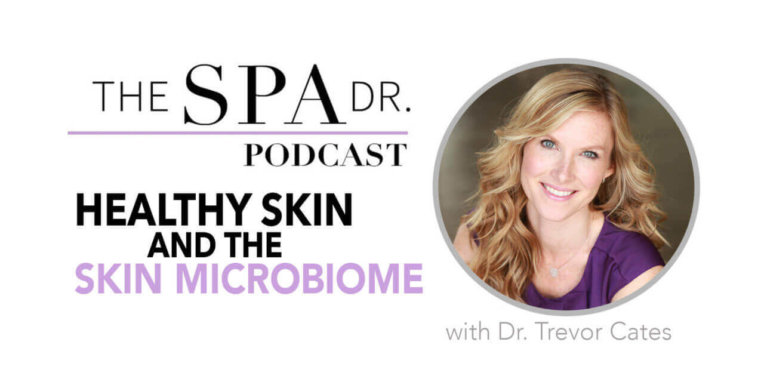

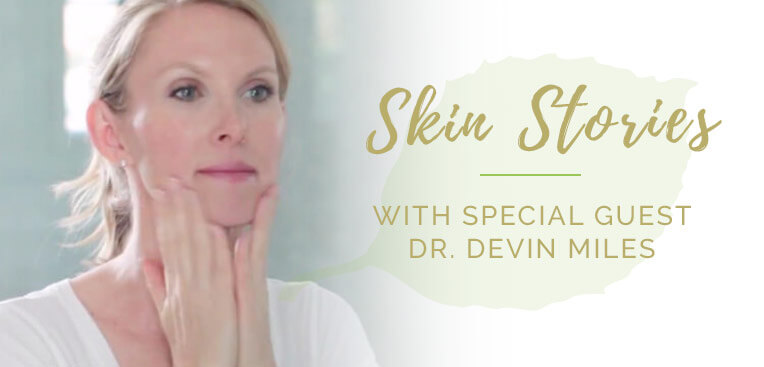
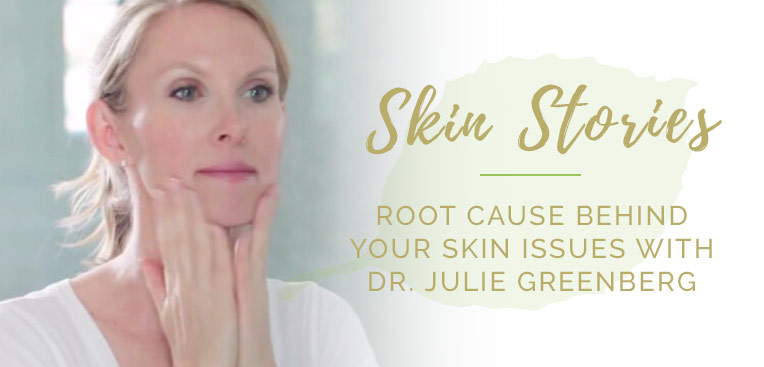
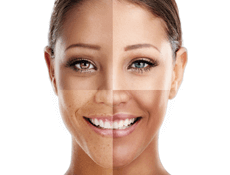
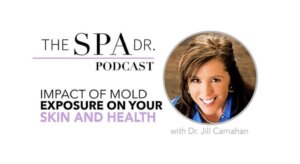


Reader Interactions
Thank you for the free download
What are topical probiotics? I have chronic eczema of hands and feet.
These are beneficial bacteria for skin that are used in skin care products. We still need more research to determine which types of probiotic skin care will work for eczema.